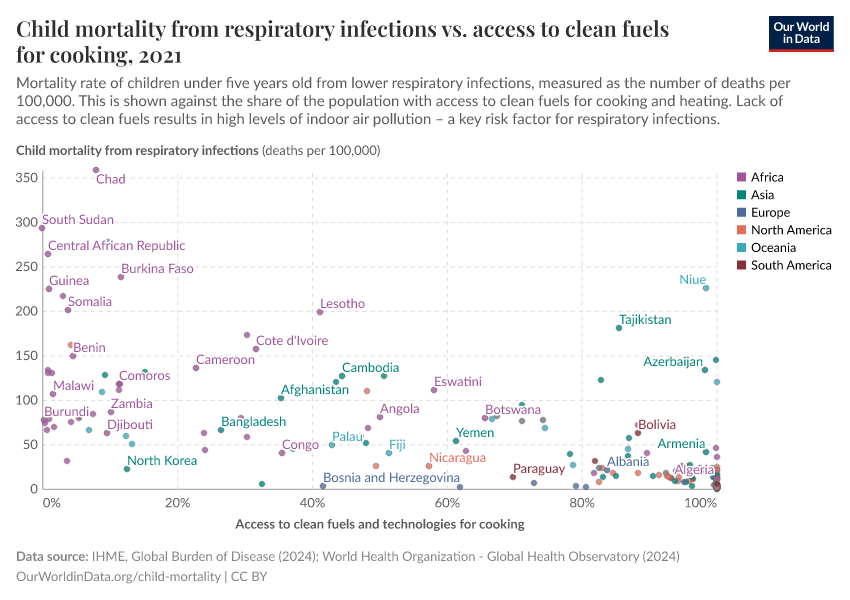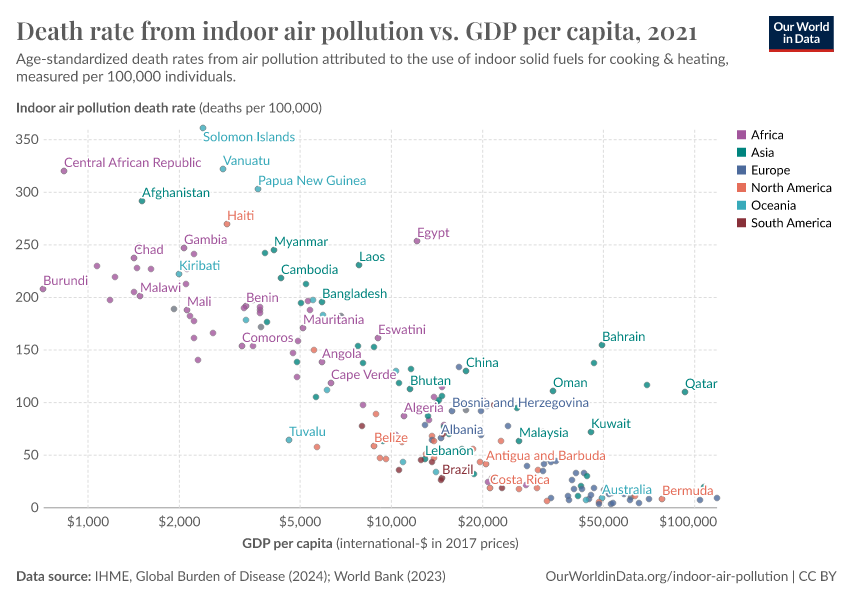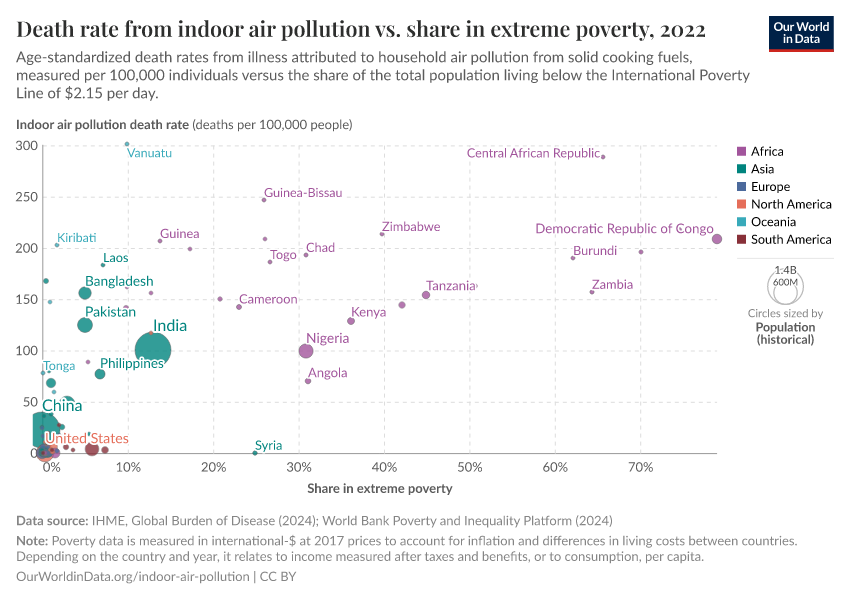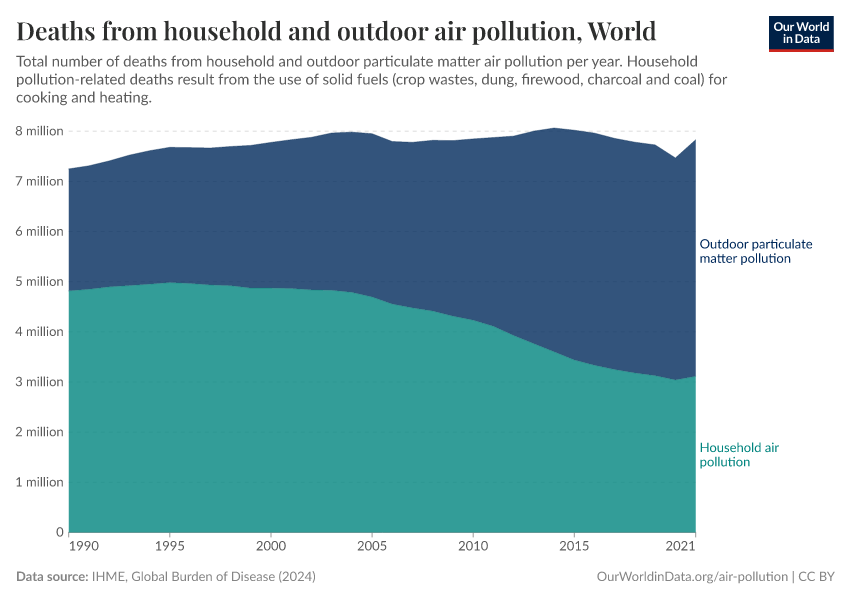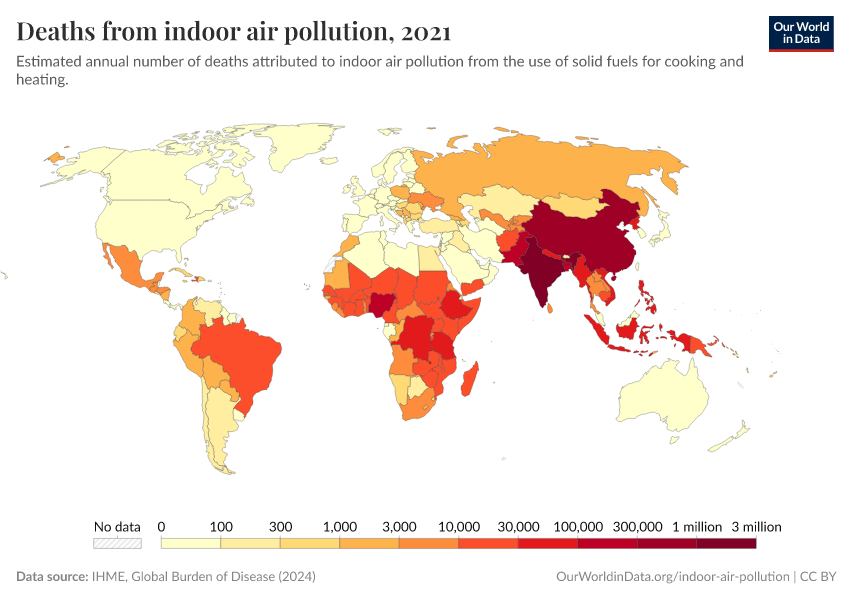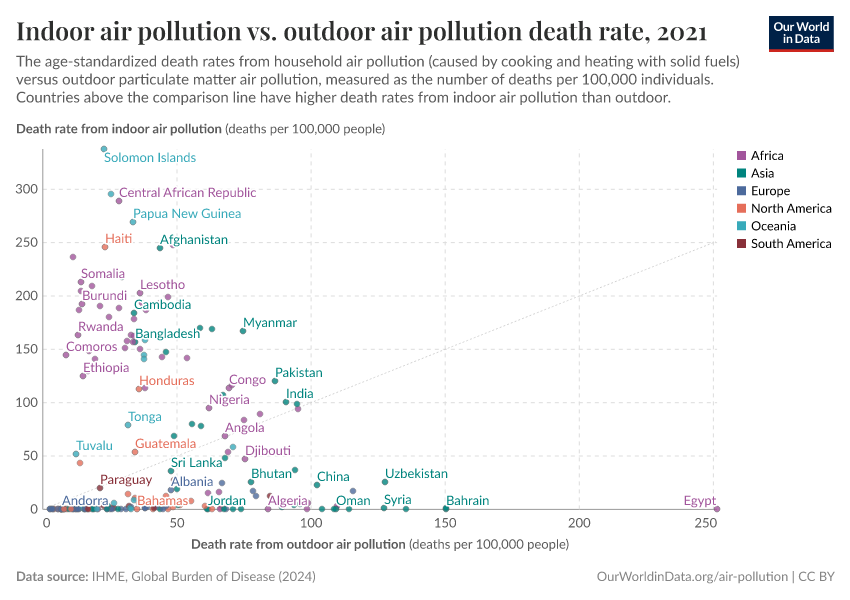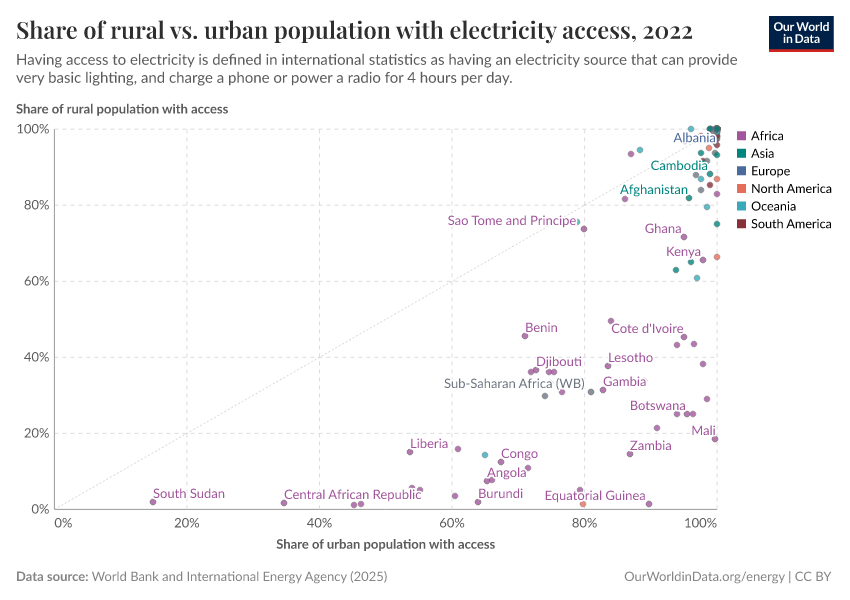Indoor Air Pollution
Indoor air pollution – caused by the burning of firewood, crop waste, and dung for cooking and heating – is a major health risk for the world's poorest.
This article was first published in November 2014. We made minor changes to the text in March 2024.
Indoor air pollution is caused by burning solid fuel sources – such as firewood, crop waste, and dung – for cooking and heating.
Burning such fuels, particularly in poor households, results in air pollution that leads to respiratory diseases, which can result in premature death. The WHO calls indoor air pollution "the world's largest single environmental health risk."1
See all interactive charts on indoor air pollution ↓
Related topics
Outdoor Air Pollution
Outdoor air pollution is one of the world’s largest health and environmental problems.
Air Pollution
Our overview of both indoor and outdoor air pollution.
Energy
Explore our data and research on global energy.
Other research and writing on indoor air pollution on Our World in Data:
- Data review: how many people die from air pollution?
- Energy poverty and indoor air pollution: a problem as old as humanity that we can end within our lifetime
Indoor air pollution is one of the leading risk factors for premature death
Indoor air pollution is a leading risk factor for deaths in poor countries
Indoor air pollution is one of the world's largest environmental problems – particularly for the poorest in the world, who often do not have access to clean fuels for cooking.
The Global Burden of Disease is a major global study on the causes and risk factors for death and disease.2 The study estimates of the annual number of deaths attributed to a wide range of risk factors are shown here. This chart is shown for the global total but can be explored for any country or region using the "change country or region" toggle.
Indoor air pollution is a risk factor for several of the world's leading causes of death, including heart disease, pneumonia, stroke, diabetes, and lung cancer.3 In the chart, we see that it is one of the leading risk factors for death globally.
The health impact of indoor air pollution is especially high in low-income countries. If we look at the breakdown for low-income countries we see that indoor air pollution is among the worst risk factors.
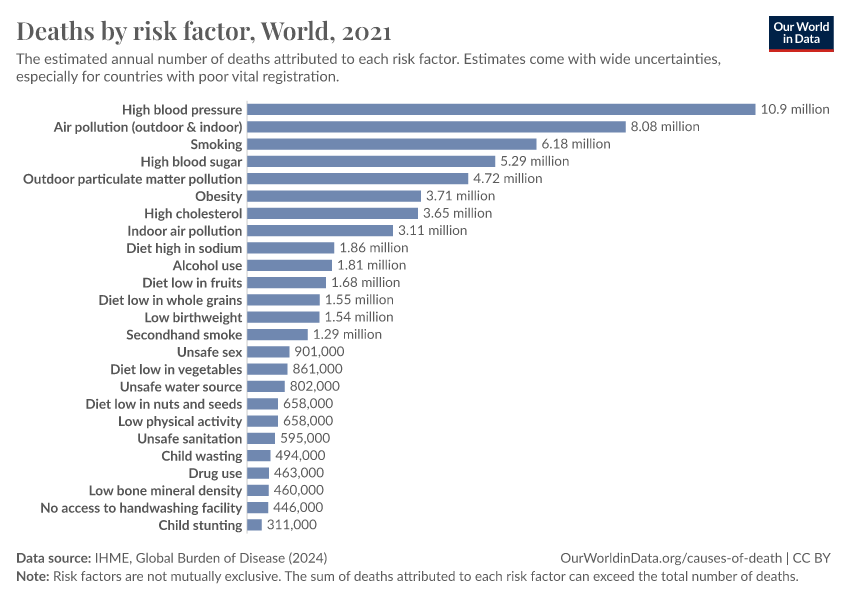
Read more on how researchers estimate the death toll caused by each risk factor here:
How do researchers estimate the death toll caused by each risk factor, whether it’s smoking, obesity, or air pollution?
Risk factors are important to understand because they can help us identify how to save lives. How do researchers estimate their impact?
The global distribution of deaths from indoor air pollution
In the map here, we see the share of annual deaths attributed to indoor air pollution across the world.
This is based on the share of deaths that are attributable to indoor air pollution based on the impact of air pollution on the risk of diseases like cardiovascular disease, lung disease, lung cancer, and others. In other words, it is an estimate of the share of all deaths that would be prevented if indoor air pollution was absent.

Death rates are highest across low-income countries
Death rates from indoor air pollution give us an accurate comparison of differences in mortality impacts between countries and over time. In contrast to the share of deaths that we studied before, death rates are not influenced by how other causes or risk factors for death are changing.
In this map, we see death rates from indoor air pollution across the world. Death rates measure the number of deaths per 100,000 people in a given country or region.
What becomes clear is the large differences in death rates between countries: rates are high in lower-income countries, particularly across Sub-Saharan Africa and Asia.
Compare these rates with those across high-income countries: across North America, rates are below 0.1 deaths per 100,000. That’s a greater than 1000-fold difference.
The issue of indoor air pollution, therefore, has a clear economic split: it is a problem that has almost been entirely eliminated across high-income countries but remains a large environmental and health problem for lower-income countries.
We see this relationship clearly when we plot death rates versus income, as shown here. There is a strong negative relationship: death rates decline as countries get richer. This is also broadly true when making this comparison between extreme poverty rates and pollution effects.

How has mortality from indoor air pollution changed over time?
Annual deaths from indoor air pollution have declined globally
Whilst indoor air pollution is still one of the leading risk factors for mortality, particularly in low-income countries, the world has also made significant progress in recent decades.
Globally, the number of annual deaths from indoor air pollution has fallen substantially since 1990. We see this in the visualization, which shows the annual number of deaths attributed to indoor air pollution globally.
This means that despite continued population growth in recent decades, the total number of deaths from indoor air pollution has still declined.

Indoor air pollution deaths have declined in most countries
We have seen this progress across a large number of countries. In the scatterplot, you see the comparison of the number of deaths from indoor air pollution in 1990 (shown on the y-axis) versus the number in the latest year (on the x-axis). The grey line here marks where the number of deaths would be equal in both years; countries which lie above the line had a higher number of deaths in 1990, and the opposite is true for countries below the line.
Most countries lie above the grey line, meaning most have seen a decline in the number of deaths from indoor air pollution in recent decades.
You can explore data on the number of deaths from indoor air pollution across the world here.

Death rates have declined in almost all countries in the world
As we know, populations have increased over recent decades, so it might be that deaths from indoor air pollution are increasing in some countries just because there are more people. To account for this, we should look at death rates – the number of deaths per 100,000 people – rather than the total number of deaths from indoor air pollution.
Which countries in the world have made progress in reducing death rates from indoor air pollution in recent decades? All countries have.
In the scatterplot here we see the comparison between the death rate from indoor air pollution in 1990 (shown on the y-axis) versus the death rate in the latest year (on the x-axis). The grey line here marks where the death rate would be equal in both years; countries that lie above the line had a higher death rate in 1990, and the opposite is true for countries below the line.
All countries lie above the grey line. This means progress has been made almost everywhere in the world in recent decades.

Deaths by age
This visualization shows the breakdown of deaths from indoor air pollution by age group.
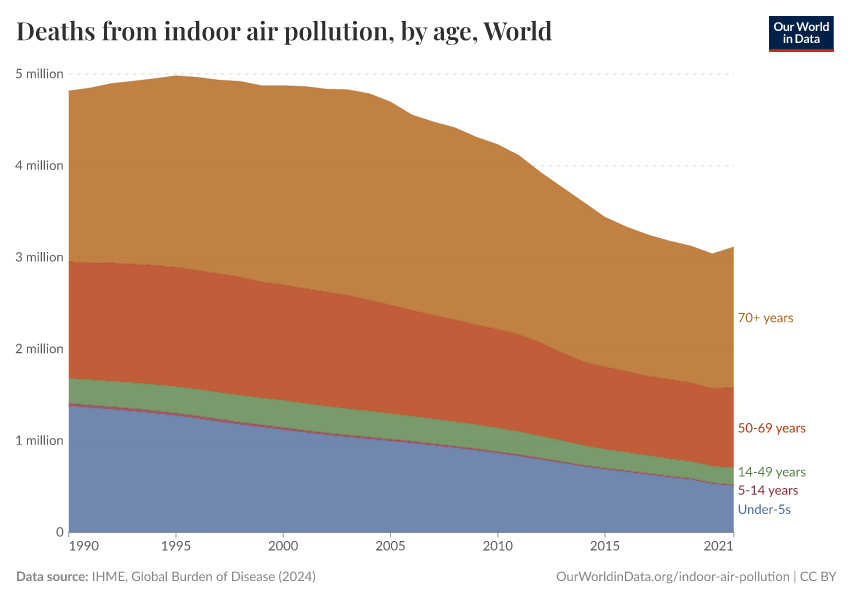
How to make progress against indoor air pollution?
Indoor air pollution results from poor access to clean cooking fuels
Indoor air pollution is mostly the result of the burning of solid fuels such as crop waste, dung, charcoal, and coal for cooking and heating in households. Burning these fuels produces particulate matter – a major health risk, particularly for respiratory diseases. The burning of such fuels in enclosed spaces, such as small households, is a major risk factor for the exacerbation of these diseases.
Low-income households tend to rely on solid fuels for cooking because cleaner fuels are either unavailable or too expensive. We, therefore, see a strong link between death rates from indoor air pollution and access to clean fuels for cooking.
This is shown in the visualization: here, we see that countries with the highest death rate from indoor air pollution are those with very low access to clean fuels (i.e., have a high dependence on solid fuels instead). As access to clean fuels and technologies increases, death rates from household air pollution begin and continue to fall.
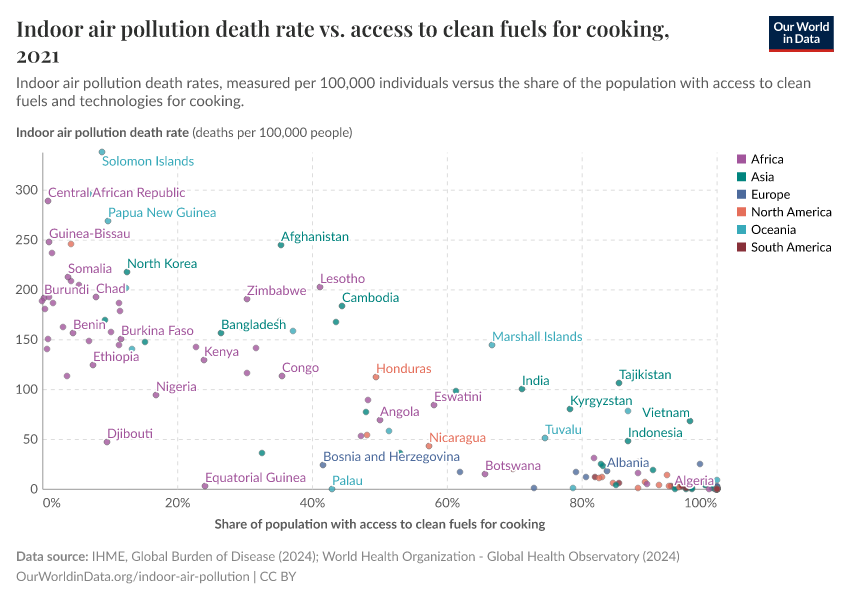
Poorer households have a higher dependence on solid fuels
Income is a strong determinant of energy access and types of fuel sources.
In the figure, we see the World Health Organization (WHO)'s depiction of the 'energy ladder'. It shows how the dominant source of energy changes depending on the level of income.
At low-income levels, households rely mostly on solid traditional fuel sources such as crop waste, dung, and firewood. As incomes rise, this energy mix tends to transition towards charcoal and coal. Only at higher income levels do households shift from harmful solid fuels to cleaner non-solid fuels such as ethanol and natural gas. Electricity is only available for households at a high-income level.
The latest data on this relationship between fuel type and income is shown in the scatterplot. It shows the percentage of households in countries around the world with access to clean fuels and technologies for cooking (on the y-axis) versus the average income in the country.
The share of households with access to clean energy in countries below a GDP per capita level of $2,000 per year is typically less than 10%. As countries begin to bridge that gap between low and middle incomes, this share begins to increase until a final transition towards high income, where the majority of households have clean fuels and technologies for cooking.
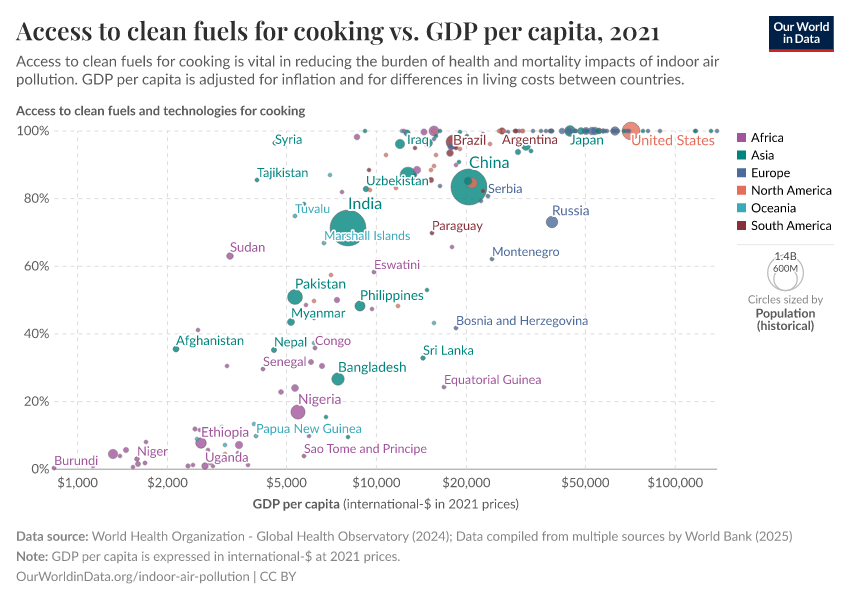
Access to clean fuels for cooking
Only 60% of the world has access to clean cooking fuels
The obvious way to avoid indoor air pollution from solid fuel burning is for households to transition from traditional ways of cooking and heating towards more modern, cleaner methods. This can, for example, be in the form of transitioning towards non-solid fuels such as natural gas, ethanol, or even electric technologies.
'Clean fuels' are defined by emission rate targets and recommendations for and against particular fuel use in the World Health Organization's guidelines for indoor air quality: household fuel combustion.4 The WHO recommends against the use of solid fuels, unprocessed coal, and kerosene for indoor cooking since these fuels exceed its emission rate targets. The 'clean fuels' recommended include biogas, ethanol, LPG, natural gas, and electricity. Solar cookstoves can also be an important solution where conditions are suitable.
The map here shows the percentage of households with access to clean fuels and technologies for cooking.
Globally, access has been increasing: in 2000, around half of households globally had access; in more recent years, this has increased to seven in ten. Still, this means access to clean fuels is not universal.
This share has been increasing for most countries with low-to-middle incomes; however, rates of increase vary by country and region.
Access is lowest across sub-Saharan Africa, where a minority of households have access to clean fuels. Progress has been much more significant in South Asia and East Asia over recent decades; in both cases, the majority of households now have access.

Use of solid fuels for cooking is still high, but it is falling
The burning of solid fuels fills the homes in poorer countries with smoke that kills the world’s poor by causing pneumonia, stroke, heart disease, chronic obstructive pulmonary disease, and lung cancer. The solid fuels responsible for this include wood, crop residues, dung, charcoal, and coal. The solution to this problem is straightforward: shift from solid fuels to modern energy sources.
The chart shows that the world is making progress in this direction. In 1980, almost two-thirds of the world’s population used solid fuels for their cooking. Thirty years later, this is down to around 40%. The chart also shows that it is a problem associated with poverty: In richer Europe and North America, the share is much lower than in the rest of the world, and in the high-income countries of the world, the use of solid fuels is entirely a thing of the past.
The use of solid fuels is going down in all of the world’s regions. However, the success of rapidly developing South East Asia is particularly impressive: here, the share fell from 95% to 61%.

Key Charts on Indoor Air Pollution
See all charts on this topicEndnotes
Murray, C. J., Aravkin, A. Y., Zheng, P., Abbafati, C., Abbas, K. M., Abbasi-Kangevari, M., ... & Borzouei, S. (2020). Global burden of 87 risk factors in 204 countries and territories, 1990–2019: a systematic analysis for the Global Burden of Disease Study 2019. The Lancet, 396(10258), 1223-1249.
WHO (2014) – Fact sheet N°292 – Household air pollution and health. Updated March 2014. Online here.
World Health Organization. (2014). WHO guidelines for indoor air quality: household fuel combustion. World Health Organization.
Cite this work
Our articles and data visualizations rely on work from many different people and organizations. When citing this topic page, please also cite the underlying data sources. This topic page can be cited as:
Hannah Ritchie and Max Roser (2022) - “Indoor Air Pollution” Published online at OurWorldinData.org. Retrieved from: 'https://ourworldindata.org/indoor-air-pollution' [Online Resource]BibTeX citation
@article{owid-indoor-air-pollution,
author = {Hannah Ritchie and Max Roser},
title = {Indoor Air Pollution},
journal = {Our World in Data},
year = {2022},
note = {https://ourworldindata.org/indoor-air-pollution}
}Reuse this work freely
All visualizations, data, and code produced by Our World in Data are completely open access under the Creative Commons BY license. You have the permission to use, distribute, and reproduce these in any medium, provided the source and authors are credited.
The data produced by third parties and made available by Our World in Data is subject to the license terms from the original third-party authors. We will always indicate the original source of the data in our documentation, so you should always check the license of any such third-party data before use and redistribution.
All of our charts can be embedded in any site.
